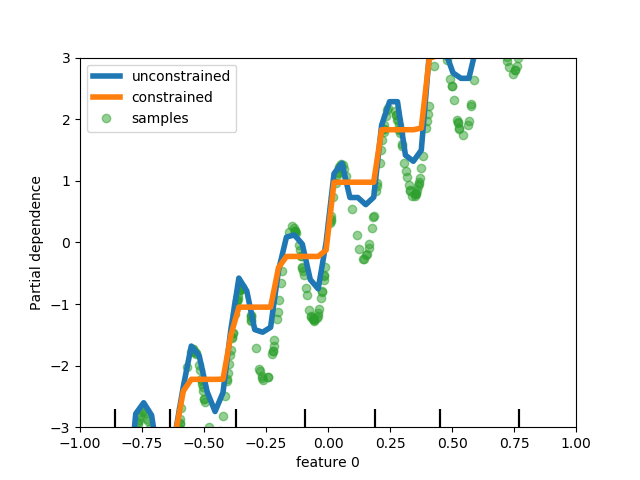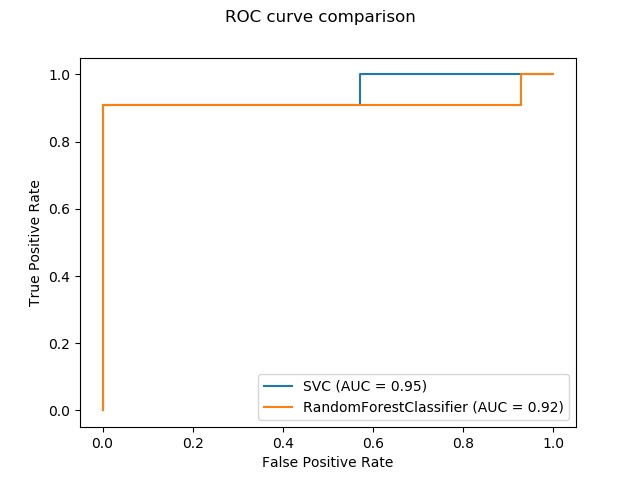sklearn.ensemble.HistGradientBoostingClassifier?
class sklearn.ensemble.HistGradientBoostingClassifier(loss='auto', *, learning_rate=0.1, max_iter=100, max_leaf_nodes=31, max_depth=None, min_samples_leaf=20, l2_regularization=0.0, max_bins=255, monotonic_cst=None, warm_start=False, early_stopping='auto', scoring='loss', validation_fraction=0.1, n_iter_no_change=10, tol=1e-07, verbose=0, random_state=None)
基于直方圖的梯度提升分類樹。
對于大數據集(n_samples >= 10000),該估計器比梯度提升分類器GradientBoostingClassifier快得多。
這個估計器對缺失值(nan)有本地支持。在訓練過程中,"種樹者"根據潛在的增益,決定每個分割點學習缺失值的樣本時是應該去左子節點還是去右子節點。在進行預測時,缺少值的樣本將被分配到左子節點或右子節點。如果在訓練過程中沒有遇到給定特征的缺失值,那么缺失值的樣本將被映射到擁有最多樣本的子特征。
這個實現受到 LightGBM的啟發。
注意
這個估計器目前還處于測試階段:預測和API可能會在沒有任何棄用周期的情況下發生變化。要使用它,您需要顯式導入enable_hist_gradient_boosting:
>>> # explicitly require this experimental feature
>>> from sklearn.experimental import enable_hist_gradient_boosting # noqa
>>> # now you can import normally from ensemble
>>> from sklearn.ensemble import HistGradientBoostingClassifier
請參閱用戶指南獲取更多信息。
0.21版本新功能。
| 參數 | 說明 |
|---|---|
| loss | {‘auto’, ‘binary_crossentropy’, ‘categorical_crossentropy’}, optional (default=’auto’) 在增壓過程中使用的損耗函數。“binary_crossentropy”(也稱為logistic損失)用于二進制分類,并概括為“categorical_crossentropy”用于多類分類。“auto”將根據問題的性質自動選擇損失。 |
| learning_rate | float, optional (default=0.1) 學習率,也稱為縮水率。這被用作葉值的一個乘法因子。使用 1表示不縮水。 |
| max_iter | int, optional (default=100) 提升過程的最大迭代次數,即二分類樹的最大數目。對于多類分類,每次迭代都會構建n_classes樹。 |
| max_leaf_nodes | int or None, optional (default=31) 每棵樹的最大葉節點數。必須嚴格大于1。如果沒有,就沒有最大限制。 |
| max_depth | int or None, optional (default=None) 每棵樹的最大深度。樹的深度是指從根到最深葉子的邊數。默認情況下深度沒有限制。 |
| min_samples_leaf | int, optional (default=20) 每個葉子的最小樣本數。對于少于幾百個樣本的小數據集,建議降低這個值,因為只會建立非常淺的樹。 |
| l2_regularization | float, optional (default=0) L2正則化參數。使用0表示不正則化(默認)。 |
| max_bins | int, optional (default=255) 用于非缺失值的最大桶數。在訓練之前,輸入數組X的每個特征都被放入整數值的箱子中,這使得訓練的速度更快。具有少量惟一值的特性可能使用小于 max_bins。除了max_bins外,還會為缺少的值保留一個容器。不能大于255。 |
| monotonic_cst | array-like of int of shape (n_features), default=None 表示要對每個特征執行的單調約束。-1、1、0分別為正約束、負約束和無約束。請參閱用戶指南獲取更多信息。 |
| warm_start | bool, optional (default=False) 當設置為True時,重用前面調用的解決方案,以適應并向集成添加更多的評估器。為了使結果有效,估計器應該只在相同的數據上重新訓練。詳見 術語表。 |
| early_stopping | ‘auto’ or bool (default=’auto’) 如果使用“auto”,則在樣本大小大于10000時啟用早期停止。如果為True,則啟用早期停止,否則禁用早期停止。 |
| scoring | str or callable or None, optional (default=’loss’) 用于早停的計分參數。它可以是單個字符串(參見The scoring parameter: defining model evaluation rules),也可以是可調用的(參見Defining your scoring strategy from metric functions)。如果沒有,則使用估計器的默認得分器。如果計分=“損失”,則根據損失值檢查提前停止。僅在提前停止時使用。 |
| validation_fraction | int or float or None, optional (default=0.1) 訓練數據的比例(或絕對大小),預留為驗證數據,以便早期停止。如果沒有,則對訓練數據進行早期停止。僅在提前停止時使用。 |
| n_iter_no_change | int, optional (default=10) 用來決定什么時候“早停止”。當最后的 n_iter_no_change得分在一定程度上都沒有優于n_iter_no_change - 1的時候,擬合過程就會停止。僅在提前停止時使用。 |
| tol | float or None, optional (default=1e-7) 在比較早期停止期間的分數時使用的絕對容忍度。容忍度越高,我們越有可能提前停止:容忍度越高,意味著后續迭代將更難被認為是參考分數的改進。 |
| verbose | int, optional (default=0) 冗長的水平。如果不是零,打印一些關于擬合過程的信息。 |
| random_state | int, np.random.RandomStateInstance or None, optional (default=None) 偽隨機數生成器,用于控制封裝過程中的子采樣,以及在啟用早期停止時,列車/驗證數據分離。在多個函數調用之間傳遞可重復輸出的int。詳見 術語表。 |
| 屬性 | 參數 |
|---|---|
| classes_ | array, shape = (n_classes,) 類標簽。 |
| n_iter_ | int 早期停止所選擇的迭代次數,取決于 early_stop參數。否則它對應max_iter。 |
| n_trees_per_iteration_ | int 在每次迭代中構建的樹的數量。對于回歸項,這總是1。 |
| train_score_ | ndarray, shape (n_iter_+1,) 訓練數據每次迭代時的得分。第一個條目是在第一次迭代之前集合的分數。根據評分參數計算分數。如果評分不是“損失”,則對最多10,000個樣本的子集計算得分。空如果沒有早期停止。 |
| validation_score_ | ndarray, shape (n_iter_+1,) 在每一次迭代中顯示的驗證數據的分數。第一個條目是在第一次迭代之前集合的分數。根據評分參數計算分數。如果沒有早期停止,則為空;如果v alidation_fraction為None。 |
示例
>>> # To use this experimental feature, we need to explicitly ask for it:
>>> from sklearn.experimental import enable_hist_gradient_boosting # noqa
>>> from sklearn.ensemble import HistGradientBoostingClassifier
>>> from sklearn.datasets import load_iris
>>> X, y = load_iris(return_X_y=True)
>>> clf = HistGradientBoostingClassifier().fit(X, y)
>>> clf.score(X, y)
1.0
方法
| 方法 | 說明 |
|---|---|
decision_function(X) |
計算X的決策函數。 |
fit(X, y[, sample_weight]) |
擬合梯度提升模型。 |
get_params([deep]) |
獲取這個估計器的參數。 |
predict(X) |
預測X的聚類。 |
predict_proba(X) |
預測X的類概率。 |
score(X, y[, sample_weight]) |
返回給定測試數據和標簽的平均精度。 |
set_params(**params) |
設置這個估計器的參數。 |
__init__(loss='least_squares', *, learning_rate=0.1, max_iter=100, max_leaf_nodes=31, max_depth=None, min_samples_leaf=20, l2_regularization=0.0, max_bins=255, monotonic_cst=None, warm_start=False, early_stopping='auto', scoring='loss', validation_fraction=0.1, n_iter_no_change=10, tol=1e-07, verbose=0, random_state=None)
初始化self。 使用help(type(self)) 獲取準確的說明。
decision_function(X)
計算X的決策函數。
| 參數 | 說明 |
|---|---|
| X | array-like, shape (n_samples, n_features) 輸入樣本 |
| 返回值 | 說明 |
|---|---|
| decision | ndarray, shape (n_samples,) or (n_samples, n_trees_per_iteration) 每個樣本的原始預測值(即樹葉的總和)。n_trees_per_iteration等于多類分類中的類數。 |
fit(X, y, sample_weight=None)
擬合梯度提升模型。
| 參數 | 說明 |
|---|---|
| X | array-like of shape (n_samples, n_features) 輸入樣本。 |
| y | array-like of shape (n_samples,) 目標值 |
| sample_weight | array-like of shape (n_samples,) default=None 權重和訓練數據 |
| 返回值 | 說明 |
|---|---|
| self | object |
get_params(deep=True)
獲取這個估計器的參數。
| 參數 | 說明 |
|---|---|
| deep | bool, default=True 如果為真,將返回此估計器的參數以及包含的作為估計器的子對象。 |
| 返回值 | 說明 |
|---|---|
| params | mapping of string to any 參數名稱映射到它們的值。 |
predict(X)
預測X的值。
| 參數 | 說明 |
|---|---|
| X | array-like, shape (n_samples, n_features) 輸入樣本 |
| 返回值 | 說明 |
|---|---|
| y | ndarray, shape (n_samples,) 預測值 |
predict_proba(X)
預測X的類概率。
| 參數 | 說明 |
|---|---|
| X | array-like, shape (n_samples, n_features) 輸入樣本 |
| 返回值 | 說明 |
|---|---|
| p | ndarray, shape (n_samples, n_classes) 輸入樣本的類概率。 |
score(X, y, sample_weight=None)
返回給定測試數據和標簽的平均精度。
在多標簽分類中,這是子集精度,這是一個苛刻的指標,因為你需要對每個樣本正確預測每個標簽集。
| 參數 | 說明 |
|---|---|
| X | array-like of shape (n_samples, n_features) 測試樣品。 |
| y | array-like of shape (n_samples,) or (n_samples, n_outputs) X的值 |
| sample_weight | array-like of shape (n_samples,), default=None 樣本權重 |
| 返回值 | 說明 |
|---|---|
| score | float R^2 of self.predict(X) wrt. y. |
set_params(**params)
設置估計器參數
該方法適用于簡單估計量和嵌套對象(如pipline)。后者具有形式為<component>_<parameter>的參數,這樣就讓更新嵌套對象的每個組件成為了可能。
| 參數 | 說明 |
|---|---|
| **params | dict 估計器參數 |
| 返回值 | 說明 |
|---|---|
| self | object 估計器實例 |



